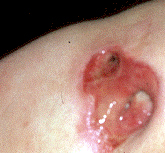|
|
|
Decubitus ulcer
Synonym:
Pressure sores
Decubitus ulcers in the skin are induced by ischemia. The basis of ischemia is usually prolonged pressure.
Pressure sores are commonly found in bedridden patients left in a fixed position for long periods of time, or in paraplegics, again for the same reason.
Erythema overlying a bony prominence can precede ulceration.
Treatment:
- Prevention depends upon maintaining good blood flow to all load bearing areas of the skin. For the bedridden patient this involves weight shifting at regular intervals; certainly every 15 to 20 minutes ideally more often. Air mattresses that inflate and deflate can be quite useful for changing body position without the need for staff help.
- The ulcer itself responds to enhanced blood flow.
- Secondary infection should be treated.
- Damaging and irritant chemicals should be avoided.
- Numerous dressings such as hydrocolloid gels are available. These are very much an improvement over the older chlorine or peroxide solutions, which often slowed healing.
- If there is secondary bacterial overgrowth, anti-bacterial preparations can be used, but only for the few days required to control the bacterial overgrowth.
- Malodorous ulcers may be improved by use of topical 0.75% metronidazole gel bid.
- In the case of debilitated patients, care should be taken to be sure that they are in a good metabolic state.
- The edge of ulcers that refuse to heal over many months should be biopsied to rule out an underlying squamous carcinoma.

Back to Dermatology Glossary - D Index |
Back to Dermatology Glossary Index
|